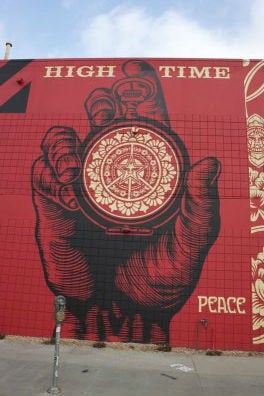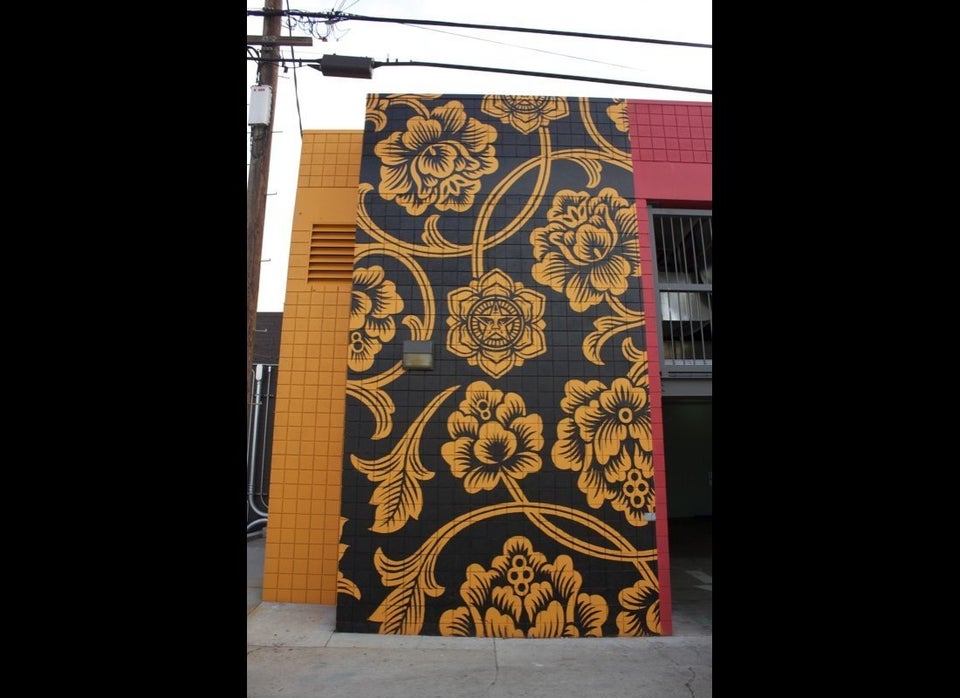
Shepard Fairey recently completed a new mural in Los Angeles on the same building that he used to illegally 'bomb' with his art. Now the building owner invited and hired Shepard to come paint the walls. This mural is a prime example of how far Fairey has taken the street art movement with his Obey campaign, and his leadership.
There is no official 'Leader' of the street art movement, but if there were it would be Shepard Fairey. Sure, Banksy might be a bigger household name, but he has remained delightfully incognito. Shepard is both an artist and a face for the movement, and with all due respect to Banksy, no one has done more to pioneer the movement and help form street art into what it is today, both in terms of unsanctioned art and as spokesperson for the genre.
When Shepard first started doing 'street art,' there was no such thing as street art. Sure, there were graffiti writers spraying their names, and bands were promoting their shows through flyers, but Fairey was the first combine elements of both and embrace print medium itself as his main artistic voice. From stickers, to stencils, to posters and wheat pastes, Fairey has taken his campaign all over the world. Some of it is legal, much of it is unsanctioned, and the result is that Shepard's street art has been embraced by mainstream culture so much that Fairey was selected to compose an image of Barack Obama for the 2008 presidential election campaign.
Not only has Shepard furthered the genre with his art, but he is also very cognizant of what he is doing with his campaigns and he has the ability to explain the aims of street art. Way back in 1990 Shepard laid out his personal Manifesto detailing how his street art is an experiment with Phenomenology. He explains that the goal is to make people more aware of their environment and thereby enable them notice things that had been obscured. In general terms, this is the aim of all street art, to interact with the environment and get people to see things, and thereby experience life, in a new way. The ability to voice himself and his pursuits so clearly and eloquently has made him the premier spokesperson for the street art movement.
In terms of propaganda, Shepard has been extremely successful in spreading his message. Speaking on a personal level, Obey was the first big name artist to touch my life. I had chanced upon a local graffiti writer laying down a tag in Miami over a decade ago, and when I asked him why he was doing it, he mentioned some names like 'Obey' and 'Banksy.' I had heard of Banksy before, but this was the first time I had heard of Obey. Then, less than a week later, I stumbled upon an Obey sticker 300 miles away from downtown Miami in the middle of a sunburban Orlando. I wondered if Obey had put it there himself and marveled at his reach. Now, I realize that that it was probably a sticker sent out in a sticker pack or along with some clothing, but it was a magical moment which indirectly led to starting the blog.
On a mega level, Shepard has built his Obey street campaign into a booming clothing company, achieved great success in galleries, designed numerous album covers, co-founded Swindle magazine along with Roger Gastman, partnered with many socio/political causes and steered street art into what it is today. He has inspired a generation of street artists, and thousands of street art tributes, especially of his infamous 'Andre the Giant Has a Posse' sticker. And this whole time, over decades, Shepard has steadily maintained a constant presence with art in the streets worldwide.
Fairey might have achieved a lot of success, but it has not been an easy ride along the way. Shepard has been arrested 15 times, waded through legal issues with appropriation and fair use, combatted charges of commercialization and corporate commissions, and even recently got physically assaulted in Copenhagen because of his art. Shepard told M&F that it wasn't nearly as bad as when he got beaten up by police while handcuffed. And right here in Los Angeles, murals are technically illegal in LA at the current time, but even the head of the city planning commission in charge of forming the new mural ordinance is a self-proclaimed 'fan-boy' of Fairey's. There is no doubt Shepard has his fans and his detractors. Fairey has earned his unofficial role of street art 'leader,' and has the street cred, and black eyes, to prove it. Through it all, Fairey has remained strong in his own personal beliefs of what an artist and a spokesperson should be, and has not wavered in his goal to reach as many people, in as many ways as possible.
It is admirable to see how Shepard has pioneered the street art movement, and it will be interesting to follow his art, and street art as a whole, in the future. This is an awesome new mural from Shepard Fairey and the art work can be appreciated on its own. But when this building is looked at in light of what Fairey has done for the street art movement, and how he has taken street art that used to be illegal and nurtured it into the same walls that are now being commissioned, this is not just a piece of art, this is a piece of history. The public can enjoy this art at the Northwest corner of La Brea and 2nd Street in Los Angeles.
Stay up~
